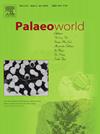中国下三叠统多元素牙形刺器(Cornudina)的高分辨率x射线显微层析成像
IF 1.7
3区 地球科学
Q2 PALEONTOLOGY
引用次数: 0
摘要
锥形牙形刺属的装置仍然是模棱两可的,因为以前的结果是来自离散元素集合而不是自然组合。利用高分辨率x射线显微层析成像技术,对安徽省合肥市巢湖马家山采石场南陵湖上组719层采集的4个保存特别完好的自然组合进行了成像。元素并置的一致和重复的模式表明了一个由15个元素组成的装置,符合经典的2M-9S-4P骨架模板,包括三种基本形态:两个短形dolabate元素,九个细长的bipenate元素和四个角形元素。P1和P2呈角状,尖部明显,前后突短,P2呈弯月牙状,属于corudina breviramulis sensu stricto Koike。Cornudina、Neostrachanognathus和Hindeodus器械的多元素比较表明Cornudina和Neostrachanognathus亲缘关系密切,可能来源于Hindeodus。奥陶系“复杂”牙形器(如Paracordylodus和Phragmodus)与三叠系“形形”器(如Cornudina和Neostrachanognathus)的多元素比较表明,后者元素形式的低变化可能是二次“进化”。本文章由计算机程序翻译,如有差异,请以英文原文为准。
Multielement conodont apparatus (Cornudina) from the Lower Triassic of China, revealed by high-resolution X-ray microtomography
The apparatus of the coniform conodont genus Cornudina remains equivocal because the previous results were derived from discrete element collections rather than natural assemblages. Four exceptionally preserved natural assemblages collected from bed 719 of the upper Nanlinghu Formation in Majiashan quarry, Chaohu of Hefei City, Anhui Province, East China, were imaged using high-resolution X-ray microtomography. The consistent and repeated patterns of element juxtaposition suggest an apparatus of 15 elements, conforming to the classical 2M-9S-4P skeletal template that comprises three basic morphologies: two breviform dolabrate elements, nine elongate bipennate elements, and four angulate elements. The angulate P1 and P2 elements have a distinct cusp, short anterior and posterior processes and the P2 element is twisted crescent-shaped, which supports a taxonomic assignment to Cornudina breviramulis sensu stricto Koike. Multielement comparisons among Cornudina, Neostrachanognathus, and Hindeodus apparatuses suggest Cornudina and Neostrachanognathus are closely related and possibly derived from Hindeodus. The multi-element comparison between Ordovician ‘complex’ conodont apparatuses (e.g., Paracordylodus and Phragmodus) and Triassic ‘coniform’ apparatuses (e.g., Cornudina and Neostrachanognathus) suggests that the low variation in the elemental forms of the latter is probably a secondary ‘evolution’.
求助全文
通过发布文献求助,成功后即可免费获取论文全文。
去求助
来源期刊

Palaeoworld
PALEONTOLOGY-
CiteScore
4.00
自引率
5.90%
发文量
95
期刊介绍:
Palaeoworld is a peer-reviewed quarterly journal dedicated to the study of past life and its environment. We encourage submission of original manuscripts on all aspects of palaeontology and stratigraphy, comparisons of regional and global data in time and space, and results generated by interdisciplinary investigations in related fields. Some issues will be devoted entirely to a special theme whereas others will be composed of contributed articles. Palaeoworld is dedicated to serving a broad spectrum of geoscientists and palaeobiologists as well as serving as a resource for students in fields as diverse as palaeobiology, evolutionary biology, taxonomy and phylogeny, geobiology, historical geology, and palaeoenvironment.
Palaeoworld publishes original articles in the following areas:
•Phylogeny and taxonomic studies of all fossil groups
•Biostratigraphy, chemostratigraphy, chronostratigraphy
•Palaeoecology, palaeoenvironment and global changes throughout Earth history
•Tempo and mode of biological evolution
•Biological events in Earth history (e.g., extinctions, radiations)
•Ecosystem evolution
•Geobiology and molecular palaeobiology
•Palaeontological and stratigraphic methods
•Interdisciplinary studies focusing on fossils and strata
 求助内容:
求助内容: 应助结果提醒方式:
应助结果提醒方式:


